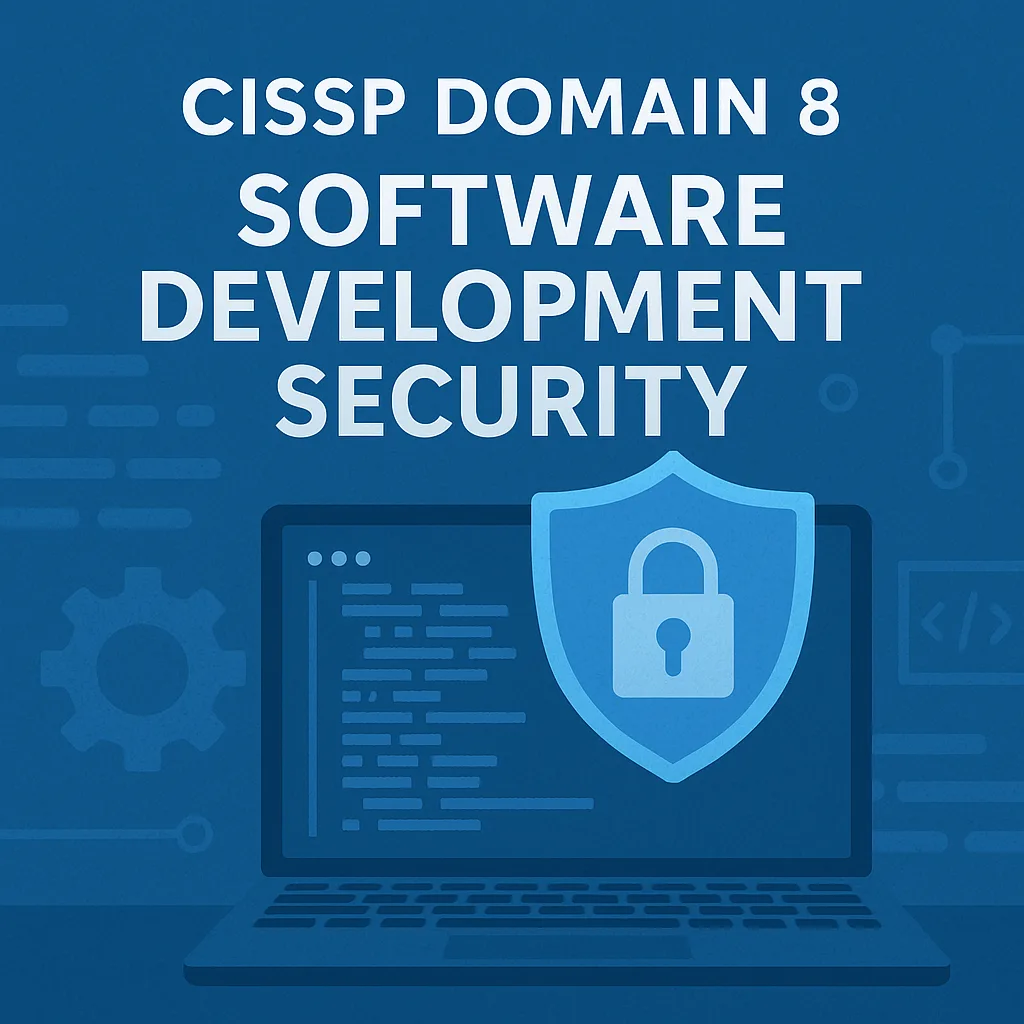CISSP Domain 8: Software Development Security focuses on integrating security practices and controls into the software development lifecycle (SDLC). It ensures that applications are developed, deployed, and maintained with a proactive approach to mitigating vulnerabilities and enforcing secure behavior.
As applications increasingly become targets for cyberattacks, this domain is essential for developers, security engineers, and CISSP candidates aiming to embed security from code to production.
Core Concepts in CISSP Domain 8
1. Secure Software Development Lifecycle (SDLC)
The SDLC incorporates security across all development phases:
- Requirements Gathering:
- Identify security requirements and regulatory needs (e.g., PCI DSS, GDPR).
- Design:
- Apply security models (e.g., STRIDE, DREAD).
- Use secure architecture patterns.
- Development:
- Follow secure coding standards (OWASP, SEI CERT).
- Perform static code analysis (SAST).
- Testing:
- Conduct dynamic analysis (DAST), fuzz testing, and penetration testing.
- Deployment:
- Ensure secure configurations and hardened environments.
- Maintenance:
- Apply patches, monitor logs, and manage vulnerabilities over time.
Security must be a continuous process—not just a one-time test before release.
2. Security Controls in Development Environments
Development environments must be secured to prevent insider threats and unauthorized access:
- Access Control: Role-based access to code repositories and build servers.
- Version Control: Tools like Git ensure traceability and change history.
- Environment Separation:
- Isolate dev, test, staging, and production environments.
- Logging and Auditing:
- Track who accesses or modifies code, build artifacts, or environments.
Hardening development environments minimizes risk during early stages of code creation.
3. Software Security Testing
- Static Application Security Testing (SAST):
- Analyzes source code or binaries without executing the program.
- Dynamic Application Security Testing (DAST):
- Tests running applications for vulnerabilities like SQL injection or XSS.
- Interactive Application Security Testing (IAST):
- Combines SAST and DAST for real-time analysis.
- Fuzz Testing:
- Provides random or malformed inputs to trigger unexpected behavior.
- Regression and Unit Testing:
- Ensure changes don’t break security controls or introduce new flaws.
Testing should be integrated into CI/CD pipelines for real-time security feedback.
4. Secure Coding Practices
Common vulnerabilities include:
- Injection Attacks (SQL, Command)
- Cross-Site Scripting (XSS)
- Broken Authentication
- Insecure Deserialization
- Security Misconfiguration
Best practices include:
- Input validation and output encoding.
- Proper error handling.
- Using secure APIs and avoiding deprecated libraries.
- Implementing session management and strong authentication.
Follow industry resources like the OWASP Top 10 and CWE/SANS Top 25.
5. DevSecOps and Automation
DevSecOps integrates security into DevOps pipelines:
- Shift-Left Security: Introduce security earlier in development.
- Automated Security Tools: Run SAST, DAST, dependency checks in CI/CD.
- Immutable Infrastructure: Build and deploy environments from secure templates.
Automation enables fast, scalable, and repeatable security checks.
6. Security in Agile, Waterfall, and Hybrid Models
Different development methodologies require different security strategies:
- Waterfall:
- Security is typically a late-stage activity.
- Use formal security gates and audit checkpoints.
- Agile:
- Continuous integration of security in short sprints.
- Security must be iterative and flexible.
- Hybrid:
- Combines elements of both—requires alignment of security with overlapping workflows.
Security professionals must adapt controls to match the pace and structure of each methodology.
7. Software Configuration and Change Management
- Configuration Management:
- Ensures integrity and consistency of code and systems.
- Change Management:
- Reviews, approvals, and testing prior to introducing new code.
- Rollback Capabilities:
- Ability to revert to previous versions in case of failure.
Managing change securely helps prevent unauthorized code or unintended consequences.
8. Database and Backend Security
- Input Sanitization:
- Prevents injection attacks at the database level.
- Access Controls:
- Enforce least privilege and role separation.
- Encryption:
- Encrypt data at rest and in transit.
- Audit Trails:
- Log queries, changes, and access attempts.
Databases often hold the most sensitive data, making their protection a priority.
9. Third-Party and Open Source Risk Management
Modern development heavily relies on libraries and frameworks:
- Software Composition Analysis (SCA): Scans for vulnerable dependencies.
- Vendor Risk Assessments: Evaluate the security posture of third-party suppliers.
- License Compliance: Ensure legal compliance with open-source usage.
Third-party code must be vetted for security, performance, and legal risk.
Why Domain 8 Matters
Poorly written or insecurely developed software can become the weakest link in an organization’s security. Domain 8 equips professionals to enforce secure coding practices, integrate security testing, and manage risk in modern development pipelines.
Conclusion
CISSP Domain 8: Software Development Security ensures that security is a fundamental element of every application. Whether writing code, managing a DevSecOps pipeline, or auditing third-party libraries, professionals must build resilient, trustworthy systems by design—not as an afterthought.


